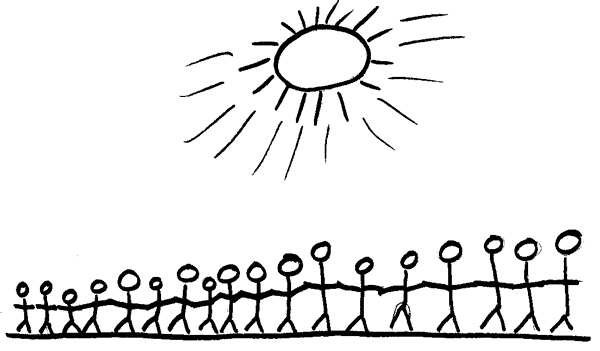
Expression and Association - Session 11
|
Roots: Parents,
communities, and governments that support
human rights for children provide an environment
which includes freedom of opinions, thoughts,
expressions, conscience, religion, and
association. (CRC Articles 12-16.)
Rights: Children have the right to
Responsibilities: Children are responsible for
Children
Parents
Materials needed: Interactive Activities
* Green paint, easel paper,
paint brush, and easel;
* Sensory table, water,
plastic, or rubber fish and other sea
creatures, fish nets;
* Building blocks that
connect with play figures;
* Colored construction
paper or newsprint and scissors for paper
chains, or colored tissue paper cut into
squares;
* white paper cut in dove shapes, paint brushes, liquid starch.
Parent Education
* Parent Education
Handout PE #11;
* Large chart paper and
pens or markers;
* Paper, pens, scissors,
string, and tape for the kite activity;
* Extra copies of the Convention on the Rights of the Child.
GreetingGreet as usual. Make sure everyone gets a name tag. Parent/Child Interactive Activitiesand paper at easel. Allow
for free expression with the paint.
2. FISH IN WATER (SENSORY)
Water play is very soothing and enjoyable to children and adults. It represents comfort, calmness, and returning to the waters that gave us birth. Assortment of plastic
fish and other water animals and small
fish nets in water at sensory table. (Fish
nets can be obtained at most pet stores.)
3. PAPER CHAIN PEOPLE
(SMALL MUSCLE)
A paper chain of people symbolizes our connectedness to each other and unity among peoples of the earth. Paper suitable for cutting
several thicknesses, scissors, and an
example pattern. Cue card explains instructions
for parents to follow.
4. TISSUE PAPER DOVES
(SMALL MUSCLE AND CREATIVE EXPRESSION)
The dove is a symbol of peace through out the world. Paper cut in the shape
of doves, assortment of colored tissue
paper, cut into small squares, and liquid
starch. Parents and children dip tissue
paper into liquid starch and stick to
paper doves. Parents and child work together
to brush the dove with liquid starch,
crumple the tissue paper squares, and
glue them onto the dove shape.
5. BOOK CORNER: (LANGUAGE)
Community Circle

3. "Today
you had the freedom to choose which activity
to do and how long you wanted to be there.
Each week you have the freedom to choose
the activities you want to do. You can
dwell in one area as long as you want
to. Sometimes, however, there are limits
to your freedoms. Who can name something
that has limited you? (Take some comments.)
Yes, our time, our ability, and our materials
can limit us. Another limit we always
need to be aware of is our responsibility
to respect others and our space, or our
environment. Did some of you experience
a limitation of respecting others?
Separate Learning Time
Now, practice this refrain: When the sun comes back, and the
first quail calls,
Parent Education Session 11 Preparation: Write this topic title, "Freedom of Thought, Expression, and Association" on chart paper and underneath write: "You have five minutes to use as you choose. This time will demonstrate (briefly) the rights we will be talking about today."
Debate Topic: Many adults feel that children are not mature enough to be able to choose with whom they will associate, and that this right will usurp parental rights to protect their child. Other people feel that young persons deserve to choose their associates and express their own opinions. This debate often centers around the age that children will be given these rights, rather than whether or not children should have these rights at all.
1. Hand out the essay: Why Children Are Like Kites (Handout PE #11 ). Read it out loud. Ask participants if they can draw parallels between what this essay says and what they have discussed in the articles. 2. Provide materials to make a paper kite and invite participants to create one. It can be as simple or elaborate as participants wish. 3. Attach the essay to the kite using glue or tape.
|
